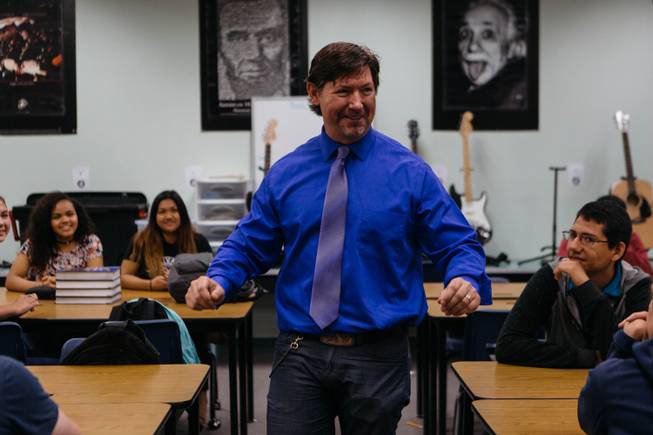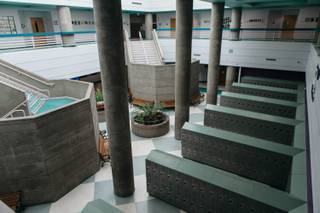
Social studies teacher Jeff Hinton teaches one of his classes at the Advanced Technologies Academy in Las Vegas on May 22, 2017.
Monday, May 29, 2017 | 2 a.m.
Graduation rates
• 99.25%: Graduation rate for A-Tech's class of 2016
• 73.5%: Graduation rate for all CCSD schools in 2016
In U.S. News & World Report’s latest ranking of 22,000 public high schools nationwide, Advanced Technologies Academy (A-Tech) came in at No. 287 overall and No. 1 in Nevada. The career and technical magnet school near downtown Las Vegas was recognized for 64.5 percent of its students being “college-ready,” 70 percent being tested in Advanced Placement courses and a general demonstration of 100 percent proficiency in mathematics and English.
That’s not a product of enrolling a certain demographic within the struggling Clark County School District, according to A-Tech principal Jonathan Synold.
“We get kids from just about every middle school in the valley,” he said. Almost 77 percent are minorities, and 43 percent qualify for the free and reduced-price lunch program. “We’re very fortunate that our demographics actually look like the district as a whole. It’s our diversity that brings kids together.”
The 2016-17 enrollment of about 1,100 students includes a senior class of 249 that racked up $9.7 million in college scholarships. Of those receiving scholarships, 32 percent will attend UNLV and 15 percent will attend UNR — noteworthy given Nevada’s problem with “brain drain,” when talent leaves seeking more robust opportunities.
County public schools face a host of challenges that contribute to consistently poor national rankings and defy a direct comparison to A-Tech. For example, the latter’s enrollment is limited by its relatively small campus and the county’s budget for magnet programs, which must cover the cost of transporting students from all over the valley to A-Tech. As a result, there are fewer than 30 students in most classes, Synold says. Each year, A-Tech accepts about 350 incoming freshmen and sophomores through a blind-lottery process. The student body during the 2016-17 school year was 1,088, whereas the average local high school serves roughly 3,000 students, most going wherever they’re zoned.
Regardless, A-Tech demonstrates exciting possibilities, and Synold says that if more families were aware of the opportunity and lottery process — mostly that A-Tech isn’t a private institution — the successful student body would become even more diverse.
“We’re publicly funded like everyone else,” he said. “We have special education students, we have students from all different backgrounds, and they are able to achieve.”
The A-Tech model
The school boasts eight areas of study: architectural design, business management, computer science, engineering, graphic design, IT networking, legal studies and web design/development.
“The idea is: All students come here with an emphasis in one specific program,” Synold said. “So it’s kind of like your college major. I view this school like a small liberal arts university, where you really are getting your major, but you’re also taking a breadth of other classes.”
Picking tracks allows new students to develop tailored four-year plans from the start, helping them focus on what needs to be done to graduate. They are expected to take some AP courses, and Synold believes that reputation for academic rigor is beneficial. It draws students who crave a challenge, and can be broadly motivating, as the baseline sets the bar high.
“It’s not an expectation that you’re going to graduate high school, that’s an assumption. ... You have kids in lower-income areas getting on the bus to come here at 5 a.m., and a lot of them will be first-generation high school graduates, which is something special,” Synold said. “It takes a special kind of student to do that.”
One great educator
In addition to the school’s national accolades, certain courses of study and teachers have been honored at that level. For the 2017-18 school year, A-Tech will have six AP readers — instructors who grade AP tests regionally — which Synold says is a nod to their expertise.
Social studies teacher Jeff Hinton won the Public Education Foundation’s Myra Greenspun Teacher’s Excellence Award (established through a donation from the Greenspun Family Foundation). He received $3,000, which he said he invested in his favorite after-school club.
“I put that money to work right away with my club on campus called Rock for Change,” Hinton said. “What we’re trying to do is put musical instruments (in students’ hands) and have kids perform after school in our rock band. The idea is to raise money for local charities and give them those hands-on experiences about what it’s like to be in a band.”
Hinton also was named Nevada’s Teacher of the Year in 2014. He credits such awards to the “outstanding faculty” and distinctive approach to education at A-Tech.
“We call it project-based learning,” he said, “and put kids into real-life situations and have them create and process that way.”
Hinton, whose teaching career spans 16 years and several schools, said he has found that method is more effective than conventional ones on both sides of the lesson.
“It’s better (for a teacher) to be more of a guide on the side than the sage on the stage,” he said, adding that students are driven by A-Tech’s culture of achievement. “When you combine that with great teaching, that really just elevates the whole thing.”


Join the Discussion:
Check this out for a full explanation of our conversion to the LiveFyre commenting system and instructions on how to sign up for an account.
Full comments policy